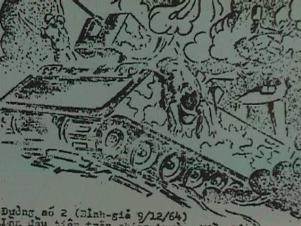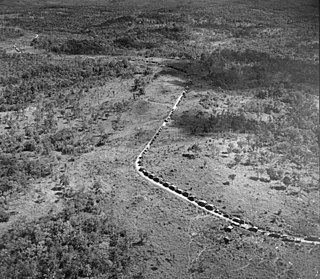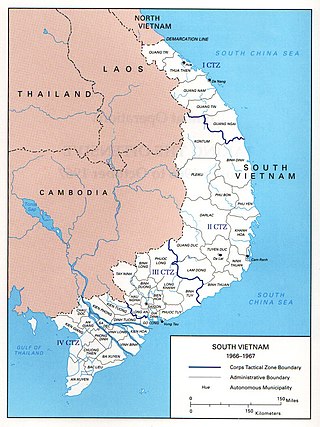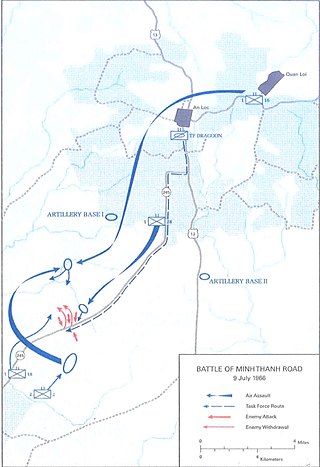
The Vietnam War was a conflict in Vietnam, Laos, and Cambodia from 1 November 1955 to the fall of Saigon on 30 April 1975. It was the second of the Indochina Wars and was a major conflict of the Cold War. While the war was officially fought between North Vietnam and South Vietnam, the north was supported by the Soviet Union, China, and other communist states, while the south was supported by the United States and other anti-communist allies, making the war a proxy war between the United States and the Soviet Union. It lasted almost 20 years, with direct U.S. military involvement ending in 1973. The conflict also spilled over into neighboring states, exacerbating the Laotian Civil War and the Cambodian Civil War, which ended with all three countries officially becoming communist states by 1976.

The Tet Offensive was a major escalation and one of the largest military campaigns of the Vietnam War. The Viet Cong (VC) and North Vietnamese People's Army of Vietnam (PAVN) launched a surprise attack on January 30, 1968 against the forces of the South Vietnamese Army of the Republic of Vietnam (ARVN), the United States Armed Forces and their allies. It was a campaign of surprise attacks against military and civilian command and control centers throughout South Vietnam. The name is the truncated version of the Lunar New Year festival name in Vietnamese, Tết Nguyên Đán, with the offense chosen during a holiday period as most ARVN personnel were on leave. The purpose of the wide-scale offensive by the Hanoi Politburo was to trigger political instability in a belief that mass armed assault on urban centers would trigger defections and rebellions.

The Battle of Đồng Xoài was a major battle fought during the Vietnam War as part of the Viet Cong (VC) Summer Offensive of 1965. It took place in Phước Long Province, South Vietnam, between June 9 and 13, 1965.

Corporal George Jarratt VC was a British Army soldier and an English recipient of the Victoria Cross (VC) the highest and most prestigious award for gallantry in the face of the enemy that can be awarded to British and Commonwealth forces.

Daniel Ford is an American journalist, novelist, and historian. The son of Patrick and Anne Ford, he attended public schools in New Hampshire and Massachusetts, graduating in 1950 from Brewster Academy in Wolfeboro, New Hampshire. He was educated at the University of New Hampshire, the University of Manchester, and King's College London.
The following outline is provided as an overview of and topical guide to the Vietnam War:

The Ballad of Andy Crocker is a 1969 American made-for-television film produced by Thomas/Spelling Productions, which was first broadcast by ABC.

The Battle of Bình Giã was conducted by the Viet Cong (VC) and People's Army of Vietnam (PAVN) from December 28, 1964, to January 1, 1965, during the Vietnam War in Bình Giã, Phước Tuy province, South Vietnam.

The Battle of Ba Gia was a major battle that marked the beginning of the Viet Cong's (VC) Summer Offensive of 1965, during the early phases of the Vietnam War. The battle took place in Quảng Ngãi Province, South Vietnam, between May 28–31, 1965.

The 1975 spring offensive, officially known as the general offensive and uprising of spring 1975, was the final North Vietnamese campaign in the Vietnam War that led to the capitulation of Republic of Vietnam. After the initial success capturing Phước Long Province, the North Vietnamese leadership increased the scope of the People's Army of Vietnam's (PAVN) offensive and captured and held the key Central Highlands city of Buôn Ma Thuột between 10 and 18 March. These operations were intended to be preparatory to launching a general offensive in 1976.

The Battle of Mang Yang Pass was one of the last battles of the First Indochina War which took place on 24 June 1954. The battle was one of the bloodiest defeats of the French Union forces, along with the battle of Dien Bien Phu shortly beforehand.
The Battle of Ban Houei Sane took place during the Vietnam War, beginning on the night of 23 January 1968, when the 24th Regiment of the People's Army of Vietnam (PAVN) 304th Division overran the small Royal Lao Army outpost at Ban Houei Sane. The fighting at Ban Houei Sane was one in a series of battles fought between North Vietnamese and Allied forces during the Tet Offensive. The small outpost, defended by the 700 man Bataillon Volontaire (BV-33), was attacked and overwhelmed by the vastly superior PAVN and their PT-76 light tanks. The failure of BV-33 to defend their outpost at Ban Houei Sane had negative consequences only a few weeks later, when the PAVN struck again at Lang Vei.

The New Year's Day battle of 1968 was a military engagement during the Vietnam War in Tây Ninh province that began on the evening of 1 January 1968. It involved units assigned to the U.S. 25th Infantry Division and two regiments of the People's Army of Vietnam (PAVN). The battle was known as the Battle of Fire Support Base Burt, or the Battle of Suoi Cut. This is not the same location as Suối Cắt village in northern Vietnam.

The defeat of the South Vietnamese Army of the Republic of Vietnam (ARVN) in a battle in January set off a furious debate in the United States on the progress being made in the war against the Viet Cong (VC) in South Vietnam. Assessments of the war flowing into the higher levels of the U.S. government in Washington, D.C. were wildly inconsistent, some citing an early victory over the VC, others a rapidly deteriorating military situation. Some senior U.S. military officers and White House officials were optimistic; civilians of the Department of State and the Central Intelligence Agency (CIA), junior military officers, and the media were decidedly less so. Near the end of the year, U.S. leaders became more pessimistic about progress in the war.

South Vietnam was in political chaos during much of the year, as generals competed for power and Buddhists protested against the government. The Viet Cong (VC) communist guerrillas expanded their operations and defeated the South Vietnamese Army of the Republic of Vietnam (ARVN) in many battles. North Vietnam made a definitive judgement in January to assist the VC insurgency with men and material. In November, North Vietnam ordered the People's Army of Vietnam (PAVN) to infiltrate units into South Vietnam and undertake joint military operations with the VC.

The 1945–46 War in Vietnam, codenamed Operation Masterdom by the British, and also known as the Southern Resistance War by the Vietnamese, was a post–World War II armed conflict involving a largely British-Indian and French task force and Japanese troops from the Southern Expeditionary Army Group, versus the Vietnamese communist movement, the Viet Minh, for control of the southern half of the country, after the unconditional Japanese surrender.
The 275th Regiment, also known as 275 Viet Cong Main Force Regiment, was a regiment of the Viet Cong (VC) during the Vietnam War. The regiment was formed in May 1965.
Operation Warzone is a 1988 American Vietnam War film.

Part of Operation El Paso II, The Battle of Minh Thanh Road took place on 9 July 1966 when a Viet Cong force attacked a 1st Infantry Division column and in turn was attacked by a larger reaction force based on three infantry battalions and supporting fire. The Viet Cong, primarily armed with RPG-2, recoilless rifles and small arms engaged and destroyed some vehicles in the initial column but were pushed back by the combined reaction force. The attacking Viet Cong unit was able to fall back using the heavy jungle in the area as cover.

Operation Muscatine was a security operation conducted during the Vietnam War by the US Army in Quảng Ngãi Province, South Vietnam from 18 December 1967 to 10 June 1968. During this operation on 16 March 1968 the 1st Battalion, 20th Infantry Regiment and the 4th Battalion, 3rd Infantry Regiment carried out the My Lai Massacre.















